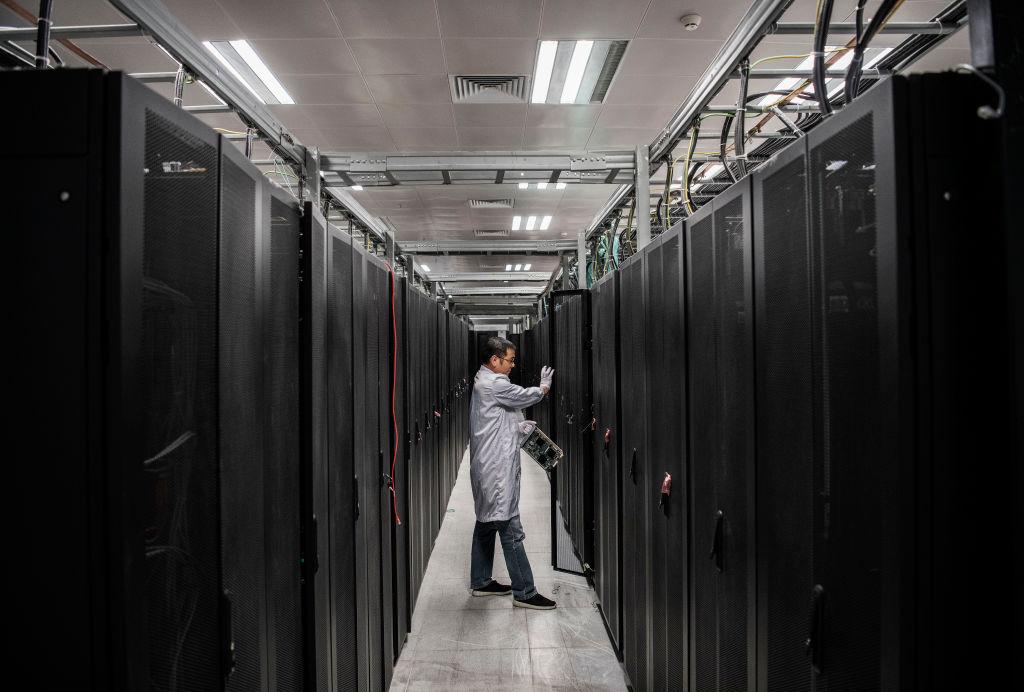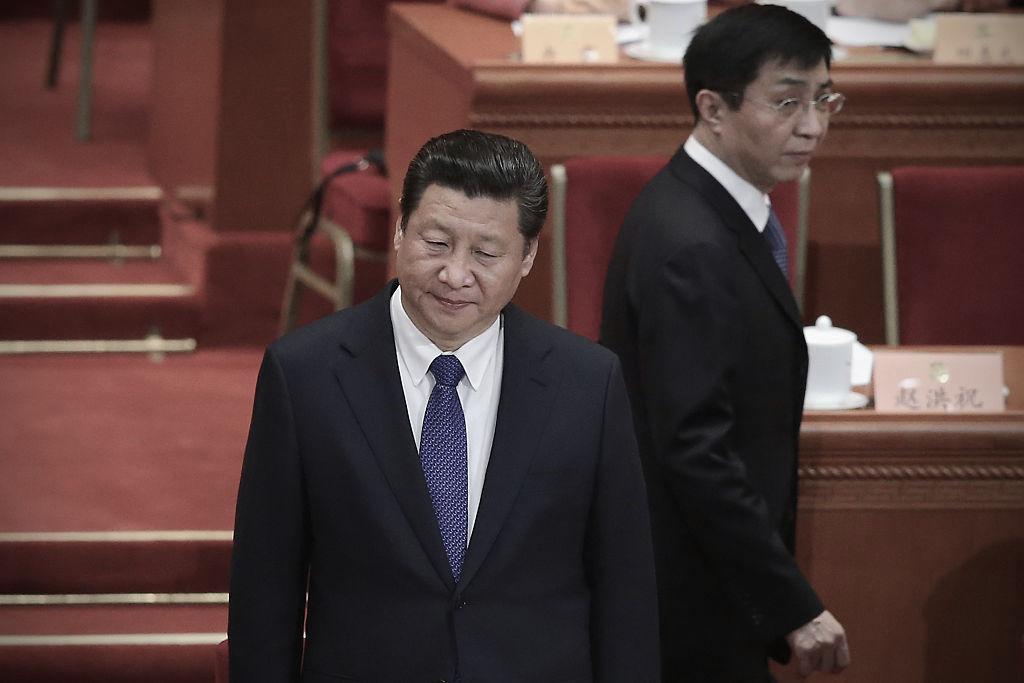The recent blackout in Texas in the United States has drawn a lot of attention from all over the world, but not many people know that similar blackouts have happened in many cities in China since the end of last year, nor do they realize the real reason behind it.
An in-depth investigation done by The Epoch Times on the structure of electricity consumption in China has led to the conclusion that its fast-growing digital surveillance industry has not only become an important new engine for the Chinese economy, but also competes with residents for power. The omnipresent digital surveillance system has also changed China into an Orwellian society, where all the data and information collected can be used and abused by the communist regime.
In the winter of 2020, Ulanqab, a big data city in Inner Mongolia, a major energy province in China, was the first to report a shortage of electricity, followed by power shortages in Hunan, Zhejiang, and other provinces. The CCP interpreted the power shortage as a result of a strong economic recovery, claiming that China is the only major economy in the world to record positive GDP growth in 2020.
State of War Status for Power Supply
In late 2020 and early 2021, China saw its first orange alert for a cold wave in nearly four years. The demand for electricity and coal increased dramatically.Amidst the severe coldness, some areas in China experienced power outages and restrictions, including Hunan, Zhejiang, Jiangxi, and Inner Mongolia, China’s major province for electricity output and a major producer of coal.
At that time, the power generation capacity of China was less than 360 gigawatts (GW). Factories in China had to open for 3 days and then close for 4 days. During the peak hours of electricity consumption, elevators in shopping malls, as well as half of the streetlights had to be turned off.
Since then, for the past 18 years, China has been aggressively building power plants, leading to severe overcapacity in the coal power industry. By the end of 2020, China’s installed power generation capacity had reached 2.2 terawatts (TW), more than six times the 2002 level.
- The resumption of industrial production increasing the demand for electricity;
- Extreme cold weather increasing the demand for electricity;
- Limited external power supply and engine breakdowns.
New Infrastructure and Digital Economy
The growth rates of electricity consumption in China in the first, second, third, and fourth quarters of 2020 are -6.5 percent, 3.9 percent, 5.8 percent, and 8.1 percent respectively, which seem to be basically in line with the GDP growth rates of -6.8 percent, 3.2 percent, 4.9 percent, and 6.5 percent in the first, second, third and fourth quarters of GDP growth respectively (as shown in Figure 1).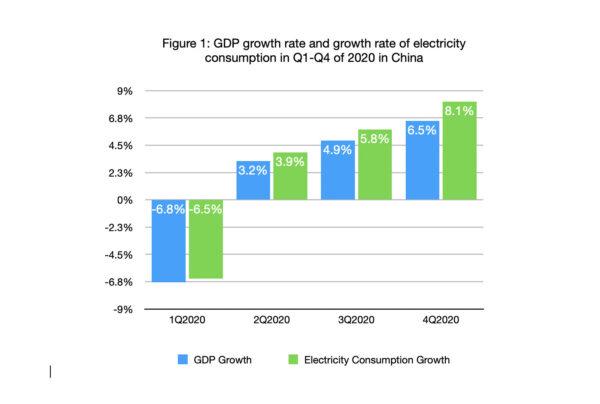
What Is the New Infrastructure?
The traditional infrastructure mainly refers to roads, railroads, bridges, airports, ports, power grids, and other facilities. According to SASAC, the CCP’s new infrastructure refers to digital infrastructures such as 5G base stations, the Internet of Things, data centers, artificial intelligence, and industrial internet.These infrastructures can digitize information and business activities, forming an economic system based on digital computing technology referred to as the digital economy.
Also noteworthy is that Hunan and Zhejiang, which were praised in the report, were also places that suffered badly from power shortages in the winter of 2020.
The report also says that “In Hangzhou, the growth of the digital economy is more obvious. Driven by leading enterprises such as Alibaba and Hikvision, the digital industries such as computer communication, electronic equipment manufacturing, information transmission, software, and information technology bucked the trend and consumed 1.975 billion kWh of electricity in the first half of the year, up 5.5 percent year-on-year, higher than the growth of the whole society’s electricity by 13.6 percentage. At present, Hangzhou has more than 50 data centers in operation, and a number of super-large data center projects such as Xinchuang Cloud and Ali East-China Cloud are under construction.”
The report says in 2020, the electricity consumption of the primary industry increased by 10.2 percent year-on-year; the electricity consumption of the secondary industry increased by 2.5 percent year-on-year (manufacturing industry in the secondary industry increased by 2.9 percent); the electricity consumption of the tertiary industry increased by 1.9 percent year-on-year; and residential electricity consumption increased by 6.9 percent.
In the meantime, “due to the rapid growth of the application of new technologies such as big data, cloud computing and the Internet of Things,” the electricity consumption in the information transmission/software and information technology services sector in China’s tertiary sector grew by 23.9 percent year-on-year, as shown in Figure 2.
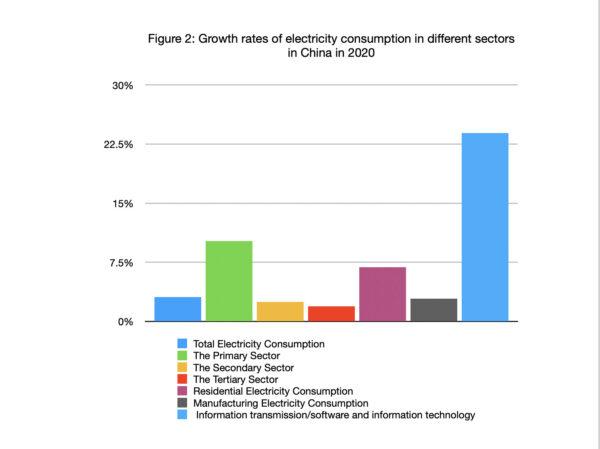
Competing for Power
While electricity consumption of the digital economy—such as 5G base stations and data centers—was growing rapidly, China once again experienced a power shortage in the winter of 2020. In the official explanation given by the CCP, the extreme cold weather and limited external power supply were blamed as having brought great pressure on the power supply system.The extreme cold weather would indeed increase residential electricity demand, although the share of residential electricity consumption in the whole society is not large (14.5 percent of the entire society’s electricity consumption in 2020).
On the other hand, residential electricity consumption level varies a lot. For example, the amount in the daytime is relatively higher, when people are working and cooking, and lower at night when most people are resting.
In the winter and summer, the demand for heating and cooling will also increase electricity consumption.
The growth rates of residential electricity consumption in China from the first to the fourth quarters of 2020 are 3.5 percent, 10.6 percent, 5.0 percent, and 10.0 percent (year on year) respectively.
When electricity consumption peaks, it will put a lot of pressure on the power supply system, and there may even be a shortage of electricity supply.
This is one of the reasons why China often suffers from power shortages in winter, which are caused by the increase in electricity consumption.
However, compared to residential electricity consumption, industrial electricity consumption, which accounts for 68 percent of China’s total electricity consumption, is more stable.
Therefore, when the CCP’s official report mentioned the limited external power supply, it mainly refers to electricity imported from other provinces, which is mainly hydroelectric power.
Since winter is a dry season, hydropower generation capacity is limited. This is another indication that the capacity of clean energy sources, such as hydropower, solar power, and wind power, is greatly affected by natural conditions. In extremely cold weather, only thermal power can provide a stable source of energy.
This is to say that the CCP officials were essentially blaming the power shortage on extreme weather, or natural disasters, regardless of whether it was because of the increase of residential electricity consumption in winter or a lack of clean energy production.
Ulanqab in Inner Mongolia: The ‘Big Data’ City of Electricity Shortage
What is the man-made disaster behind the power shortages?According to the Chinese website Caixin.com, Inner Mongolia Autonomous Region was the first to experience a power shortage in November 2020. On Nov. 25, Ulanqab revealed that it was experiencing a power shortage.
However, Ulanqab’s province, Inner Mongolia Autonomous Region, is a major energy-rich province in China. It not only supplies electricity externally to 10 provinces and regions, but is also one of China’s major coal production bases, which produces more than a quarter of the country’s coal.
Inner Mongolia’s electricity consumption was 286 TWh, so the outgoing power accounted for about one-third of its power generation capacity.
The report from bjx.com also mentioned that coal-fired power, which provides a stable supply of electricity, is the main source of power in Inner Mongolia, thanks to its abundant coal resources, accounting for 84 percent of generated electricity.
Most of the coal power plants in Inner Mongolia are pithead plants near the mouths of coal mines. Therefore, it is easier for these plants to have access to coal than many other coal power plants in other regions, such as in Hunan Province. This makes it unlikely that there will be a shortage of coal-fired power in Inner Mongolia due to the lack of coal.
Then why would Inner Mongolia, which is a major power supplier and a major coal production province, be the first to report a shortage of electricity in winter?
The article says the staples for this small Inner Mongolian city of 2.87 million people were once farming and herding. However, since Huawei decided to establish a data center in this city in 2013, Ulanqab has not only become the northern base of the national big data disaster preparedness center, but also a big data center for many companies such as Alibaba and Huaishou.
According to Ulanqab city authorities, the city’s gross regional product in 2019 was 80.84 billion yuan ($12.46 billion), of which the contributions of the primary, secondary and tertiary industries were 12.87 billion yuan ($1.98 billion, up 2.4 percent year-on-year), 31.64 billion yuan ($4.88 billion, up 11.1 percent year-on-year) and 36.35 billion yuan ($5.60 billion, up 3.6 percent year-on-year) respectively.
The contribution proportions of the primary, secondary, and tertiary industries to the gross regional product were 15.9 percent, 39.1 percent, and 45 percent respectively.
This shows that the tertiary industry took the lead, while new technologies including big data, cloud computing, information transmission/software, and information technology service all belong to the tertiary industry.
The contributions of the primary, secondary, and tertiary industries to the gross regional product were 15.6 percent, 55 percent, and 29.4 percent respectively.
Compared to the figures for 2019, the proportion of the tertiary industry has increased significantly from 29.4 percent in 2013 to 45 percent in 2019, which shows that the data center contributed greatly to this increase, as shown in Figure 3.
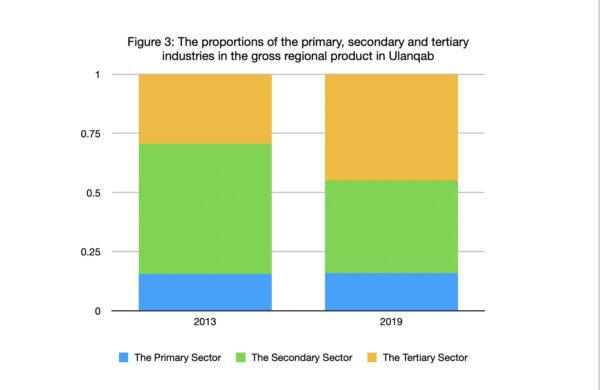
The big data industry changed this city from a windy and poor farming and herding area with 76.3 percent forest and grass coverage into a national data center like the one in Guizhou, Southern China.
Data Centers: Energy Consumption Giants
Whenever a data center is mentioned, people often think about a row of computer racks, which seem to consume much less energy than the steel plants with their big smoking chimneys.But actually, compared to ordinary server rooms, data centers have very high requirements in terms of temperature, humidity, magnetic field interference, and other conditions, which are all very demanding.
Apart from uninterrupted power, a lot of equipment, such as air conditioners and chillers are also required to assist with lighting and cooling. According to the analysis of iResearch Consulting Group, electricity accounts for 56.7 percent of the operating cost of data centers.
Hunan Province, which was the first to announce a Wartime Status for power supply last December, announced 86 provincial-level key projects for the development of big data and blockchain industries at the beginning of 2020, with provincial authorities calling for the vigorous development of big data.
In Zhejiang province, where the power supply had once been disconnected or limited, many data centers have also been established. In Hangzhou city alone, there are more than 50 data centers in operation.
The maximum power consumption of 5G is not only 3-4 times higher than 4G, but its coverage area is also smaller.
At present, the power consumption of 5G base stations of several major manufacturers in China are 4,940W for Datang, 3,500W for Huawei, and 3,255W for ZTE, while in the 4G era, the power consumption of a single base system station was only 1,300W.
Meanwhile, the coverage radius of 5G base stations is 300 to 500 meters. So at least three 5G base stations are required to cover the area of a 4G base station under the same condition.
In August 2020, China Unicom’s Luoyang Branch shut down some of its 5G base stations during some time slots in the night due to high electricity costs, sending a signal to the world about the high power consumption of 5G base stations.
Contributions of New Infrastructure And Digital Economy
After the outbreak of the CCP virus in early 2020, new infrastructures such as 5G, artificial intelligence, big data, cloud computing, and the Internet of Things were given high priority by the CCP and were directly included in the CCP regime’s work report.The new infrastructure can also attract a large amount of investment, which can further boost economic growth.
The Omnipresent Surveillance Network
On the official website of HuaweiCloud, CampusGo is presented as a model smart system to provide management for commercial and residential buildings, as well as urban governance. It can provide intrusion detection, remnant detection, facial identity verification, wandering detection, vehicle license plate recognition, and other intelligent analysis technologies; as well as leading technologies such as intelligent algorithms and deep learning to ensure high-precision perception and processing of information of faces, vehicles, events and behaviors.In doing so, all the data and information collected can be used and abused by the CCP.
The CCP can also use various methods to monitor people, such as voice recognition, emotion recognition, and cell phone tapping. This requires sophisticated algorithms and data analysis to achieve.
Surveillance: The New Engine of China’s Economic Growth
On Jan. 19, 2021, the CCP announced an annual GDP growth rate of 2.3 percent, and said that China had thus become the only major economy in the world to record positive GDP growth in 2020. Among all sectors, the information transmission, software, and information technology services sector, which includes big data and cloud computing, grew the fastest, up 16.9 percent year-on-year.According to the white paper, “the year 2019 saw the added value of the digital economy in China hitting RMB 35.8 trillion, accounting for 36.2 percent of GDP.” “On a comparable basis, the nominal growth of China’s digital economy in 2019 was 15.6 percent, about 7.85 percecnt higher than that of GDP in the same period.”
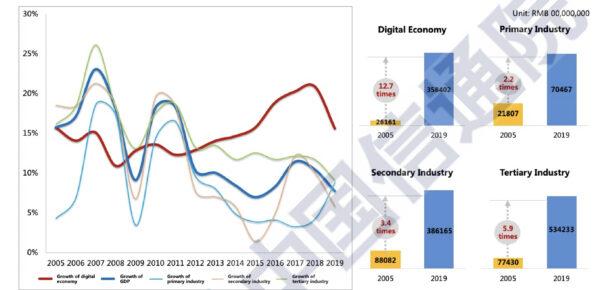
Behind the development of the digital economy is the prevalence of the CCP’s surveillance and human rights abuses. After laying out an omnipresent surveillance net, the CCP closely tracks what 1.4 billion people in China say, see, and do every day, minute, and second; analyzing people’s behavior, economic activities, daily consumption, and even culture and entertainment activities.
The CCP has also expanded its surveillance network overseas by helping international organizations such as the United Nations to establish data centers.
“Key individuals” are the main targets of CCP suppression, including Falun Gong practitioners, petitioners, human rights defenders (including human rights lawyers), dissidents, protesters, and ethnic minority groups such as Uyghurs.
The number of “key individuals” under surveillance has increased significantly as the scope of the CCP’s persecution has expanded, as more and more people start to criticize the CCP.
Unfortunately, what many people in the world see is the GDP growth in China, and quite a lot of overseas investors are still being attracted to the economic benefits there.
